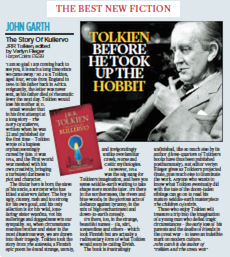 Here’s a short review of Tolkien’s The Story of Kullervo that I wrote for the Mail On Sunday when the book came out in September 2015. I reproduce it here, with permission, as the book becomes available in the USA, where I’m currently based as Fellow in Humanistic Studies at the Beverly Rogers, Carol C. Harter Black Mountain Institute, UNLV, Nevada. I’ve restored my original phrasing and made one factual correction. The newspaper headline was ‘Tolkien before he took up The Hobbit’.
Here’s a short review of Tolkien’s The Story of Kullervo that I wrote for the Mail On Sunday when the book came out in September 2015. I reproduce it here, with permission, as the book becomes available in the USA, where I’m currently based as Fellow in Humanistic Studies at the Beverly Rogers, Carol C. Harter Black Mountain Institute, UNLV, Nevada. I’ve restored my original phrasing and made one factual correction. The newspaper headline was ‘Tolkien before he took up The Hobbit’.
The Story of Kullervo by J R R Tolkien, edited by Verlyn Flieger (US: Houghton Mifflin Harcourt; UK: HarperCollins)
‘I am so glad I am coming back to see you it is such a long time since we came away.’ So J R R Tolkien, aged four, wrote from England in 1896 to his father back in southern Africa. Poignantly, the letter was never posted, because his father died of rheumatic fever the very next day. Tolkien went on to lose his mother at 12.
Small wonder, then, that in his first attempt at a long story – the Story of Kullervo, written at 22 – Tolkien wrote of a hapless orphan seemingly cursed by fate. It was 1914, and the First World War meshed with his own creative ferment, bringing a turbulent darkness to plot and character.
The titular hero is born the slave of his uncle, a sorcerer who has killed Kullervo’s father. The boy is ugly, clumsy, rash and too strong for his own good, and his only affection is for his ‘wild, lone-faring’ sister Wanōna. Yet his sufferings and doggedness win our sympathy. And so, when tragic circumstance reunites brother and sister in the most disastrous way, we are drawn into the knot of tragedy.
Tolkien took the story from the Kalevala, the Finnish national epic, which he found strange, unruly, and invigoratingly unlike the overfamiliar Greek, Norse and Celtic mythologies.
However, 1914 was the Big Bang for Tolkien’s imagination, and in The Story of Kullervo you can just about sense Middle-earth waiting to take shape just months later. It’s there in the northernness, the rivers and blue woods; in the glorious acts of defiance against tyranny; in the mix of high enchantment and epic with down-to-earth comedy.
 It’s there in the strange, beautiful names – Ilu, Sāri, Kemenūme and others – which look Finnish but are actually a rudimentary form of what Tolkien was soon calling Elvish.
It’s there in the strange, beautiful names – Ilu, Sāri, Kemenūme and others – which look Finnish but are actually a rudimentary form of what Tolkien was soon calling Elvish.
The Story of Kullervo is frustratingly unfinished, like so much else by its author (about three quarters of whose books have therefore been published posthumously). But editor Verlyn Flieger gives us Tolkien’s projected finale, plus much else to illuminate the work. And anyone who wants to know what Tolkien eventually did with the tale of the doom-laden siblings can go on to read his mature Middle-earth masterpiece The Children of Húrin.
Those who enjoy Tolkien will treasure this excursion into the imagination of a young man who defied his own tragic circumstance – the early loss of parents and the deaths of friends in the Great War – to leave an indelible mark on modern culture.




A puissant review of an unpleasant, but essential, book. Well done, John.
When I was writing about Tolkien and Kullervo in my paper published in Lembas-extra 1993/1994, I said, “I do not know what is known about the first version (or versions?) of Tolkien’s story […]: the earliest version published is the Tale of Turambar.” Maybe I was unusual in my ignorance even then, but it is delightful to think how much you and Verlyn Flieger have done since then. Happily, I’ve been catching up on your attention to Tolkien and the Kalevala in general and Kullervo in particular. Sadly, I have not yet read what Verlyn Flieger has made available and written about it in doing so.
The answer to a question that intrigues me may, then, have been available for years, without my knowing it. In my paper I observed, “It is not every reader whether of ‘Kirby’s poor translation’ or another, who will as readily perceive the greatness or feel the tragic force of the Kullervo story as Tolkien did.” In a note to this, however, I directed attention to “Sibelius’s ‘Symphonic Poem for soloists, chorus and orchestra’, Kullervo, Op. 7 (1892), which very successfully gives a sense of the greatness and power of the story.” My question is, do we know whether Tolkien knew of this, or even knew it, or Sibelius’s other Kalevala-related works?
Thanks for your comment, David. I’m aware of no evidence that Tolkien had a taste for Sibelius, but I think he would have been living in a very peculiar bubble not to have been aware of his Kalevala-inspired work. His best friend during his final years at school, Christopher Wiseman, was an avid music-lover, and so was Edith Tolkien; and it hardly needs saying that he had a wide circle of acquaintances and he read the newspapers. The only reference to Sibelius in Verlyn Flieger’s edition of The Story of Kullervo is a comment that when Tolkien imagined leaving scope in his legendarium for ‘other minds and hands wielding paint and music and drama’ (Letters, pp. 144–5), he may have been thinking of the Kalevala, Sibelius’s music, and the paintings of Akseli Gallen-Kallela. I see that David Bratman draws parallels between Tolkien and Sibelius in his paper ‘Liquid Tolkien’ in Brad Eden’s Middle-earth Minstrel: Essays on Music in Tolkien (2010).
Thank you for such a detailed response – with such attractive prospects of further reading!
The link between JRRT & Sibelius seems likely.
Tolkien may have heard of the existence of Sibelius’ Kullervo symphony, but he could not have heard it, at least before 1971. Although he composed the symphony in 1892, Sibelius, who was an inveterate perfectionist, refused to have it published before his death in 1957.
However, Tolkien may have heard it live with Edith before his death, as it was recorded in 1971 by Paavo Berglund, conducting the (of all places!) Bournemouth Symphony Orchestra. He may have heard several other Sibelius pieces there after his move to Bournemouth in 1968, as Berglund was guest conductor there from 1965.
The Kullervo symphony music eminently fits the Tale of Túrin Turambar, along with much of Sibelius’ brooding yet enchanting music, especially his tone poems.
I discovered Sibelius and the Kalevala via Tolkien after reading Carpenter’s Biography in 1976.
Lemminkäinen in Tuonela (3rd of his 4 Legends from the Kalevala), or Lemminkäinen’s descent into Hell, also suits Canto 13 of the Lay of Leithian.
Links:
https://en.wikipedia.org/wiki/Jean_Sibelius
https://en.wikipedia.org/wiki/Kullervo_(Sibelius)
https://en.wikipedia.org/wiki/Bournemouth_Symphony_Orchestra
https://en.wikipedia.org/wiki/Paavo_Berglund
https://en.wikipedia.org/wiki/Lemmink%C3%A4inen_Suite
Just to note that the picture on the front of the Story of Kullervo is described in a dream attributed to Ramer in The Notion Club Papers
https://notionclubpapers.blogspot.com/2010/11/another-ramer-tolkien-parallel.html
From The Notion Club Papers, page 194.
[Ramer] “Here are some of the [dream] fragments of this kind. (…)
“And over and over again, in many stages of growth and many different lights and shadows, three tall trees, slender, foot to foot on a green mound, and crowned with an embracing halo of blue and gold.”
That’s a great observation! The only thing lacking is the green mound, but the distinctive “halo” makes it a certainty. Thank you!
Thank you for the connection which had escaped me.
The same three trees occur in the drawing called ‘Eeriness’. In my review of Tolkien Maker of Middle-earth for Tolkien Studies, I comment on these drawings as follows. “In Eeriness (p.169), a wizard-like figure with cloak, hat and staff is facing a path between two rows of menacing trees. A dog or cat-like figure appears on the back of his cloak. As the three slender trees appearing lit from within in the left of Eeriness may be the same as those at the centre of The Land of Pohja (p.177), the figure may represent Väinämoïnen, the wizard in the Kalevala. The latter artwork includes an ingenious quasi-theatrical device, not presented in the exhibition, namely a purple flap which covers the top left-hand corner of the page and which, when turned, shows a freezing land where the Sun and Moon have been stolen by Louhi, the Old Mistress of Pohjola.” The three “Blessed Trees” (a quote from the same page of The Notion Club Papers) from the drawings, dated 1914, would be the forerunners of Silpion and Laurelin which appear less than a year later in the watercolour of The Shores of Faery.
Tolkien, as a master of thrift, kept reusing evocative themes and imagery in various guises and incarnations throughout his life. This is actually a characteristic of his creative style. Once part of the ‘leaf-mould’ of his mind, elements keep reappearing, sometimes bleeding across his universes. Later, on the following page in The Notion Club Papers (p.195), he gives a saying “A mountain far in the North caught in a slow sunset is not the Sun”, which, beyond its symbolic meaning, may also be an evocation of The Land of Pohja.